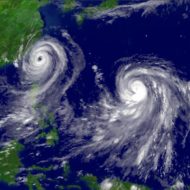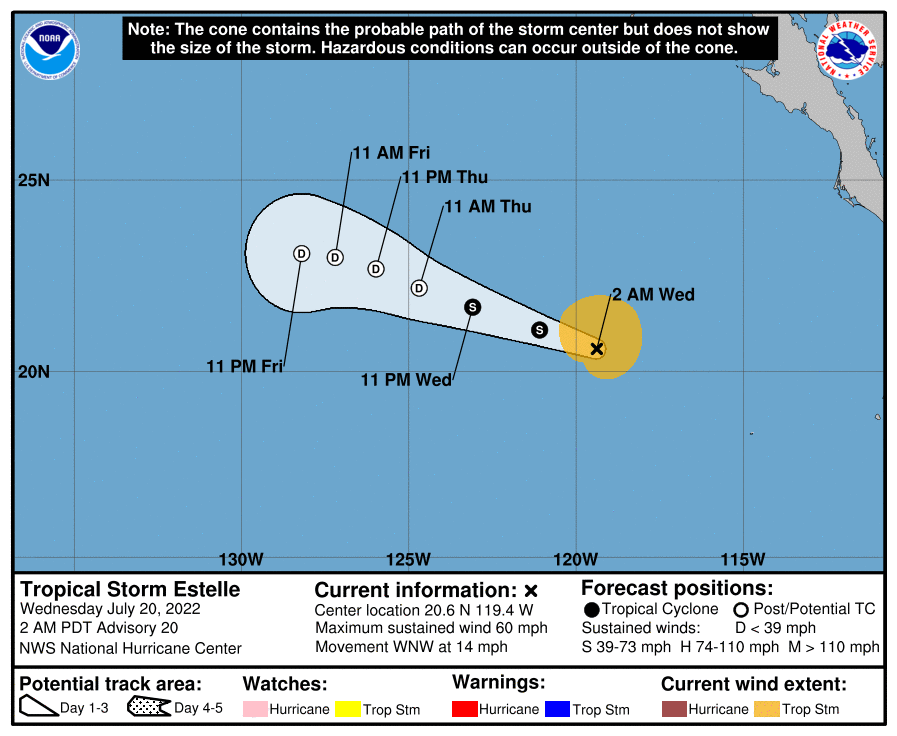KMZ last updated Thu, 28 Jul 2022 08:49:42 GMT
Source link
Tropical Depression Seven-E Forecast Discussion
000 WTPZ42 KNHC 260856 CCA TCDEP2 Tropical Depression Seven-E Discussion Number 1...Corrected NWS National Hurricane Center Miami FL EP072022 400 AM CDT Tue Jul 26 2022 Conventional satellite imagery shows that deep convection associated with the low pressure area south of southern Mexico has continued to increase and become better organized. An earlier SSMIS microwave overpass revealed an improved low-level structure, although most of the deep convection was located over the western portion of the system due to moderate easterly shear. A couple of scatterometer overpasses between 0330 and 0500 UTC showed that the circulation had become much better defined and the system had peak winds around 30 kt. Subjective Dvorak T-numbers from SAB and TAFB have also increased to T2.0, and based on all the above data, advisories are being initiated on Tropical Depression Seven-E. The initial wind speed is set at 30 kt, in agreement with both the ASCAT data and the subjective Dvorak estimates. Moderate easterly shear is forecast to plague the system over the next 24 to 48 hours, however most of the intensity guidance suggests gradual strengthening will occur during that time. The official forecast follows suit and calls for the depression to become a tropical storm later today or tonight. After 48 hours, the shear is expected to abate while the system is over SSTs of 28-29C and within a moist low- to mid-level environment. Those conditions favor a faster rate of strengthening, and this is reflected in the NHC forecast which shows the system becoming a hurricane in about 72 hours. The intensity forecast is in good agreement with the HCCA and IVCN consensus aids and is also supported by the global model guidance which depicts more significant deepening in 2-3 days. The initial motion estimate is a somewhat uncertain 280/10 kt. The cyclone is expected to continue westward for the next few days while it is steered by a subtropical ridge that extends westward from northern Mexico. After that time, the GFS and ECMWF models develop a slight weakness in the ridge off the coast of Baja California which allows the system to turn west-northwestward. The UKMET depicts a stronger ridge and a more westward track than the remainder of the guidance and its ensemble mean. As a result, the official forecast is closer to a blend of the GFS and ECMWF models, and a bit north and east of the TVCE multi-model consensus. FORECAST POSITIONS AND MAX WINDS INIT 26/0900Z 11.4N 101.8W 30 KT 35 MPH 12H 26/1800Z 11.8N 103.6W 35 KT 40 MPH 24H 27/0600Z 12.1N 105.6W 40 KT 45 MPH 36H 27/1800Z 12.2N 107.4W 45 KT 50 MPH 48H 28/0600Z 12.5N 109.1W 50 KT 60 MPH 60H 28/1800Z 12.8N 110.8W 60 KT 70 MPH 72H 29/0600Z 13.3N 112.6W 70 KT 80 MPH 96H 30/0600Z 14.9N 116.2W 80 KT 90 MPH 120H 31/0600Z 17.5N 119.7W 80 KT 90 MPH $$ Forecaster Brown
OpenStreetMap
OpenStreetMap is a map of the world, created by people like you and free to use under an open license.
Hosting is supported by UCL, Fastly, Bytemark Hosting, and other partners.
TROPICAL STORM ESTELLE
TROPICAL STORM ESTELLE
Coastal Watches/Warnings and Forecast Cone for Storm Center

* If the storm is forecast to dissipate within 3 days, the “Full Forecast” and “3 day” graphic will be identical
Click Here for a 5-day Cone Printer Friendly Graphic
How to use the cone graphic (video):

About this product:
This graphic shows an approximate representation of coastal areas under a hurricane warning (red), hurricane watch (pink),
tropical storm warning (blue) and tropical storm watch (yellow). The orange circle indicates the current position of the
center of the tropical cyclone. The black line, when selected, and dots show the National Hurricane Center (NHC) forecast track of the center
at the times indicated. The dot indicating the forecast center location will be black if the cyclone is forecast to be
tropical and will be white with a black outline if the cyclone is forecast to be extratropical. If only an L is displayed,
then the system is forecast to be a remnant low. The letter inside the dot indicates the NHC’s forecast intensity for that time:
D: Tropical Depression – wind speed less than 39 MPH
S: Tropical Storm – wind speed between 39 MPH and 73 MPH
H: Hurricane – wind speed between 74 MPH and 110 MPH
M: Major Hurricane – wind speed greater than 110 MPH
NHC tropical cyclone forecast tracks can be in error. This forecast
uncertainty is conveyed by the track forecast “cone”, the solid white
and stippled white areas in the graphic. The solid white area depicts
the track forecast uncertainty for days 1-3 of the forecast, while the
stippled area depicts the uncertainty on days 4-5. Historical data
indicate that the entire 5-day path of the center of the tropical
cyclone will remain within the cone about 60-70% of the time. To
form the cone, a set of imaginary circles are placed along the
forecast track at the 12, 24, 36, 48, 72, 96, and 120 h positions,
where the size of each circle is set so that it encloses 67% of the
previous five years official forecast errors. The cone is then formed
by smoothly connecting the area swept out by the set of circles.
It is also important to realize that a tropical cyclone is not a point. Their
effects can span many hundreds of miles from the center. The area
experiencing hurricane force (one-minute average wind speeds of at least
74 mph) and tropical storm force (one-minute average wind speeds of
39-73 mph) winds can extend well beyond the white areas shown enclosing
the most likely track area of the center. The distribution of hurricane
and tropical storm force winds in this tropical cyclone can be seen in
the Wind History graphic linked above.
Considering the combined forecast uncertainties in track, intensity, and size, the
chances that any particular location will experience winds of 34 kt (tropical storm force),
50 kt, or 64 kt (hurricane force) from this tropical cyclone are presented in
tabular form for selected locations and forecast positions. This information is also presented in
graphical form for the 34 kt, 50 kt,
and 64 kt thresholds.
Note: A detailed definition of the NHC track forecast cone is also available.
OpenStreetMap
OpenStreetMap is a map of the world, created by people like you and free to use under an open license.
Hosting is supported by UCL, Fastly, Bytemark Hosting, and other partners.
Advisory #004 Forecast Track [kmz] – Tropical Storm Estelle (EP1/EP062022)
KMZ last updated Sat, 16 Jul 2022 08:38:49 GMT
Source link
Hurricane Darby Forecast Discussion
000 WTPZ45 KNHC 140901 TCDEP5 Hurricane Darby Discussion Number 20 NWS National Hurricane Center Miami FL EP052022 Issued by NWS Central Pacific Hurricane Center Honolulu HI 1100 PM HST Wed Jul 13 2022 Darby's satellite presentation was still quite impressive near analysis time this evening, with persistent cold cloud tops surrounding a clear eye. However, some degradation in the cyclone's appearance has been noted over the past couple of hours. The eye has cooled and become a little elongated, and the cyclone appears to be entraining environmental dry air, leading to recently-observed breaks in the eye wall. The initial intensity is estimated to be near 95 kt, representing a slight weakening from the previous advisory, with Darby now below major hurricane strength. This estimate is in line with a blend of the subjective Dvorak intensity estimates from HFO/TAFB/SAB, the latest UW-CIMSS objective Dvorak estimate of 95 kt, and a SATCON value of 97 kt. Despite Darby holding its own over the past 24-36 hours, significant weakening is anticipated over the next couple of days. This is supported by all of the reliable guidance, with Darby expected to dissipate by this weekend as it passes south of the main Hawaiian Islands. The updated intensity forecast closely follows the consensus IVCN, as well as the SHIPS guidance. Darby lies on the southwestern periphery of a ridge aloft, in an area characterized by light to moderate vertical wind shear. As Darby is driven west-northwestward by a mid- and upper-level ridge to the northeast in the short term, it will move closer to a upper-level trough to it's northwest, into an environment characterized by stronger vertical wind shear. This shear will allow the cyclone to efficiently ingest the dry mid-level air that prevails, while ths system moves over sub-26C SSTs. Darby is expected to degrade to a shallow system over the next 48 hours, with a persistent strong surface high north of Hawaii forcing Darby to accelerate as it makes a turn toward the west. The updated track forecast is close to the previous forecast, and lies very close to the GFEX. Darby is crossing into the central Pacific basin, and this will be the final NHC advisory on this system. Future information on Darby can be found in Forecast/Advisories issued by the Central Pacific Hurricane Center beginning at 1500 UTC under AWIPS header HFOTCMCP1 and WMO header WTPA21 PHFO. For information specific to the Hawaiian Islands, users should continue to consult products from the National Weather Service Forecast Office in Honolulu, Hawaii, at www.weather.gov/hfo. FORECAST POSITIONS AND MAX WINDS INIT 14/0900Z 16.2N 139.5W 95 KT 110 MPH 12H 14/1800Z 16.6N 141.6W 85 KT 100 MPH 24H 15/0600Z 17.0N 144.2W 70 KT 80 MPH 36H 15/1800Z 17.1N 146.9W 55 KT 65 MPH 48H 16/0600Z 17.0N 149.8W 40 KT 45 MPH...POST-TROPICAL 60H 16/1800Z 16.9N 153.3W 30 KT 35 MPH...POST-TROP/REMNT LOW 72H 17/0600Z...DISSIPATED $$ Forecaster Birchard
OpenStreetMap
OpenStreetMap is a map of the world, created by people like you and free to use under an open license.
Hosting is supported by UCL, Fastly, Bytemark Hosting, and other partners.
OpenStreetMap
OpenStreetMap is a map of the world, created by people like you and free to use under an open license.
Hosting is supported by UCL, Fastly, Bytemark Hosting, and other partners.
Advisory #003 Forecast Track [kmz] – Tropical Storm Darby (EP5/EP052022)
KMZ last updated Sun, 10 Jul 2022 08:43:30 GMT
Source link


